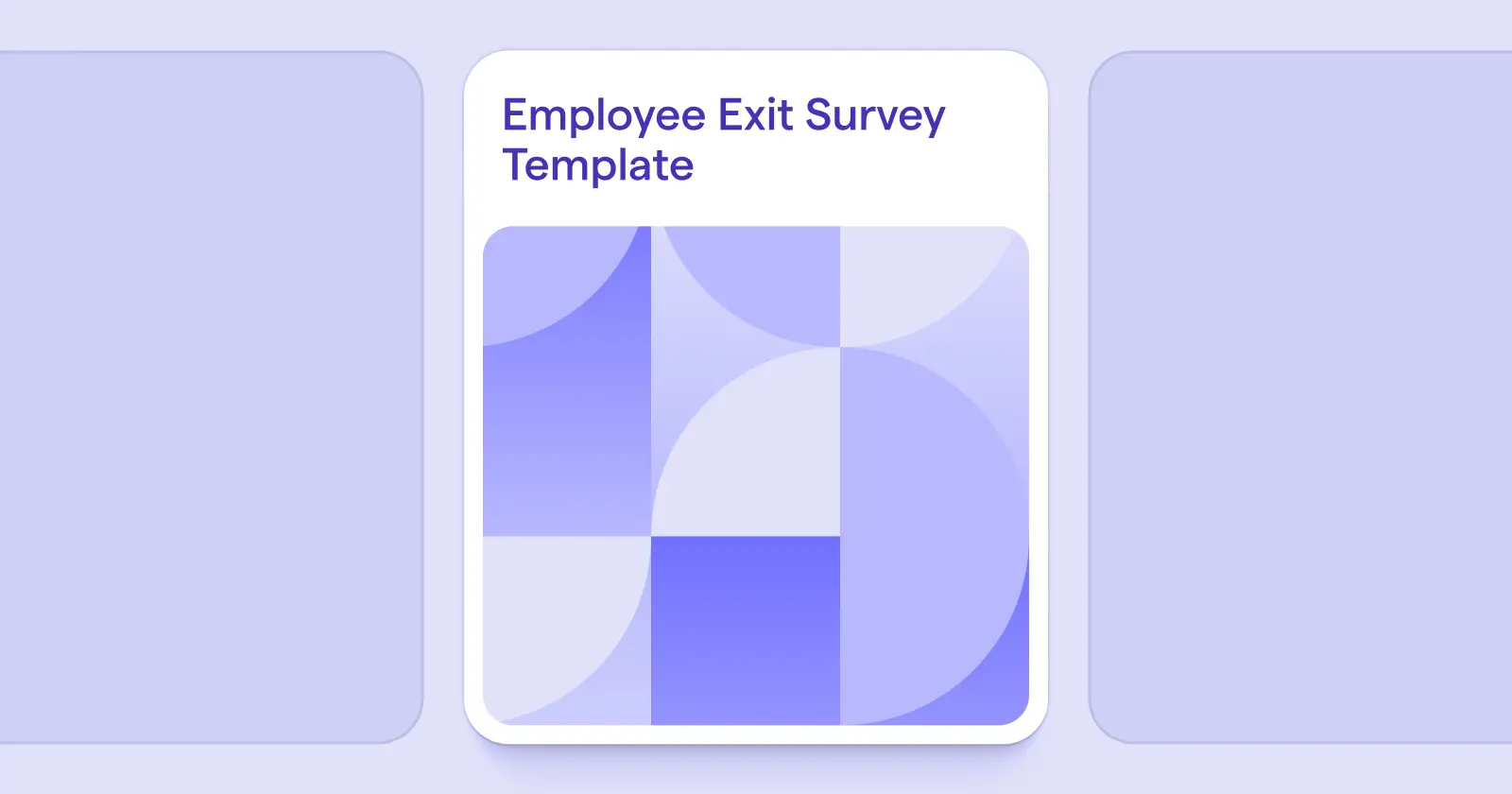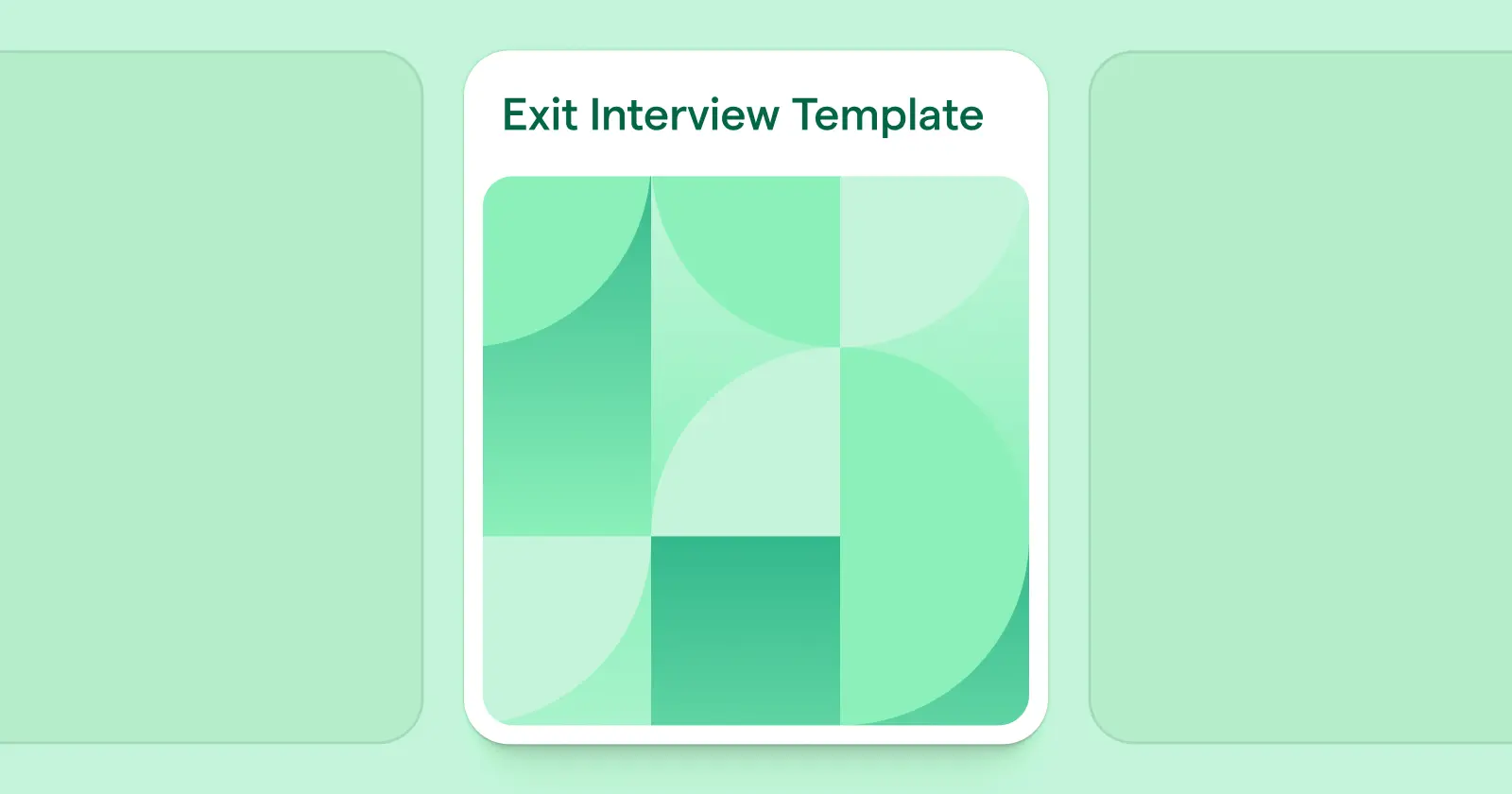When an employee hands in their notice, they’re also handing HR a golden opportunity. When collected and used in the right way, exit feedback helps human resources teams gain a deeper understanding of turnover, including ways to improve the employee experience for others.
Used separately, exit surveys and exit interviews both offer valuable ways to collect this feedback. But the real magic happens when they’re used together. Surveys provide scalable, quantitative data. Interviews provide nuance and context.
{{rich-takeaway}}
Why Exit Feedback Matters
Exit feedback isn’t just a way to pump departing employees for information. It’s an opportunity for them to share the good, the bad, and the potentially ugly truth about their experience.
“Exit data can be a powerful tool,” said Sophie Hurcombe, VP of People at Lattice. “Not just to replace what was lost, but evolve the role and address root causes that may have contributed to the departure.” She added that exit data can also be used to improve the employee experience for those still at the company, because it offers signals into whether your people strategy is driving the intended experience for your employees.
Typically, employees are at their most honest when they’re about to leave a company. By taking the time to collect their feedback, organizations can identify and diagnose systemic issues, better understand the impact of managers, and reduce regrettable attrition.
What’s the Difference Between Exit Surveys and Exit Interviews?
Exit surveys and exit interviews shine a light on opinions and perspectives that can be crucial for the recruitment and retention of future employees. These details often resonate with employees who are still on the team, so they can be used to improve their experience as well.
Hurcombe noted that a common misconception is that it’s an either-or choice between exit surveys or exit interviews. “In reality they can be very complimentary. Surveys can help capture the quantitative data and trends over time, whereas an interview can help bring more qualitative context and colour to the survey insights,” she explained.
While using both exit surveys and exit interviews might seem redundant at first, they actually complement each other. When combined, they help fill in any gaps to create a fuller picture of employee attrition.
Here’s a quick rundown of the differences between exit surveys and exit interviews for the organization, HR, and departing employees.
Why Exit Surveys and Exit Interviews Are Better Together
Exit surveys and exit interviews aren’t an either-or choice. Combining the two gives HR a full picture of the employee lifecycle.
Here’s why HR teams benefit the most from using interviews and surveys together:
- Collect differing and complementary information: While surveys are best used to measure the offboarding process, interviews can give much more nuanced intel about the larger employee experience. Surveys can help flag issues worth digging into during exit interviews, which can also help explain anomalies in the data. Using just one or the other may lead HR teams to miss out on valuable information that can be used to support new hires.
- Offer accessible opportunities for employees: Some employees may open up more in one setting than another based on their comfort level. Asynchronous communications, like surveys and questionnaires, may be more accessible to employees who need flexibility or privacy when giving feedback, while interviews give others the chance to freely share their thoughts and opinions in a one-on-one setting.
- Capture the employee lifecycle holistically: Because every employee is unique, qualitative data can help illustrate the full portrait of an employee’s experience. This extends from the moment they found the job description to the final moment of their offboarding, including feedback about their work environment, job expectations, and growth opportunities.
- Differentiate between individual needs and larger trends: The more data you have to work with, the easier it is to identify patterns contributing to turnover. Deep dives into reasons for leaving can help HR teams understand whether a negative experience was isolated or indicative of a larger problem.

Exit surveys and interviews serve different purposes. But together, they’re a powerhouse of information. “Exit surveys help you capture high-level themes and view trends across employees,” said Hurcombe. She also noted that some employees may feel more comfortable being open in a written survey, rather than an in-person discussion.
On the other hand, exit interviews dig deeper into the details behind someone’s departure. But to be effective, Hurcombe noted trust and openness are crucial. “It can really help bring more colour and context to what’s happening within the organization and why they are leaving. It can also help folks feel heard as they’re departing the organization.”
What if your HR team doesn’t have the bandwidth to do both?
Before employees leave, small or time-stretched HR teams may need to make hard decisions about the best way to gain valuable information. While surveys can be administered quickly and at scale, you might not get the same detailed information as you would from exit interviews.
To maximize efficiency, Hurcombe recommends sending an exit survey first, and using the high-level themes and discussion points from this as the starting point for an exit interview. “Then you can come prepared to ask clarifying questions or go a little deeper into areas that may need more attention or action,” she added.
But, if your HR team doesn’t have any bandwidth to run both, Hurcombe recommends adding a question to the exit survey, asking if the departing employee would like to have a one-to-one exit interview. “That way you’re still offering that in-person touchpoint for those who may want to discuss in more detail, but you’re managing your time effectively when operating as a lean team.”
If you’re struggling with time constraints, start by using a template to standardize exit survey questions. If you’re planning to rely only on exit surveys, you can still capture opportunities for improvement by incorporating some of the questions you might have used in an interview.
{{rich-highlight-1}}
Lattice’s customizable and identifiable exit surveys allow HR teams to add mutually beneficial questions like: ‘If we have follow-up questions, would you be willing to speak with HR?’ If something important or ambiguous comes up in the survey, your team can decide whether they have time to do a deeper dive with a face-to-face interview.
One of the most effective ways to make the most of your HR team’s time, while also collecting exit insights, is to use AI.
Integrating AI Into Exit Surveys and Exit Interviews
AI has the potential to transform HR processes, with Lattice's 2025 State of People Strategy Report showing some of the most popular use cases include writing job descriptions, performance reviews, and employee handbooks.
But it’s also got huge potential to streamline the exit interview and exit survey process. Here’s what that can look like:
- Smarter survey and interview creation: Instead of relying on generic templates, generative AI tools like ChatGPT can quickly create personalized questions based on an employee’s role, tenure, department, and more. Questions can also be tailored to departure type, with different options for voluntary versus involuntary exits.
- Analyzing sentiment and themes at scale: Manual analysis of exit surveys and interviews is seriously time-consuming. Lattice AI can automatically detect sentiment in open-text responses, pulling out key topics around negative and positive experiences. AI also makes it possible to quickly group qualitative feedback into key themes, for example, manager trust, career growth, burnout, or workload.
- Presentation-ready slides: Lattice AI can automatically generate leadership-ready slide decks covering top themes across departments, potential areas of risk, and what actions have been taken as a result of common employee feedback.

Using Exit Surveys and Exit Interviews Together: Designing the Right Process
Creating the right process for conducting exit surveys and interviews takes a little time, but it’s worth the effort. Use these best practices to make things as easy as possible.
When designing exit surveys:
- Keep it short: Aim for 10-15 questions, which should take around 10 minutes to complete.
- Strike the right tone: Use neutral, conversational language and no leading questions. For best results, use a bank of validated questions.
- Enable optional comments: This means you can collect valuable qualitative data, and means employees share detailed opinions if they want to.
- Ensure anonymity (if possible): This encourages honest feedback, but might not be practical in smaller teams. For identifiable surveys, make sure anyone completing the survey understands who will see the results and how the survey data will be used.
- Cover key themes: Include questions around responsibilities, training, employee experience, diversity, equity, inclusion, and belonging (DEIB) and manager effectiveness, in addition to reasons for leaving, and whether they’d recommend the company to others.
When creating exit interviews:
- Choose the right interviewer: A neutral HR representative is usually the best choice for exit interviews. Exiting employees may be less willing to discuss the reasons for leaving with their manager, which can create bias and discomfort.
- Do your research: Whoever conducts the interview should come prepared with background information about that specific employee, so they can ask meaningful questions.
- Choose the right time: If possible, the exit interview process should be scheduled within the last two weeks of an employee’s tenure, not their last day.
- Make it a two-way conversation: Exit interviews aren’t just a data collection exercise. They’re a chance for employees to ask questions, so make sure there’s enough time to allow for this.
- Create psychological safety: Exit interviews are a learning opportunity for employers, so frame them as an open conversation, not an interrogation. A consistent script can help guide conversations and ensure fairness while still leaving room for dialogue.
{{rich-highlight-2}}
Using Employee Exit Data Strategically
You’ve completed your surveys and conducted your interviews. Now what? This information is a goldmine, so rather than leaving it gathering dust on the shelf, it’s important to use it strategically.
The only wrong way to use exit data is not to use it at all. Here’s how to understand departure trends and create a process that turns feedback into insight, and insight into action.
1. Create a connected feedback loop.
Exit surveys should be sent out to departing employees first, before their exit interview. That way, HR teams can draw from the survey results when compiling questions for the exit interview. This helps collect more relevant, targeted, and useful answers than a generic interview template.
Then, use the interview results to update and improve surveys for future use. Think about the following: What information was missing about the exiting employee? What issues leading them to leave could be affecting employee retention at large? (A stay interview for remaining employees might help, too.)
It’s also important to share summaries of exit trends with current employees, and let them know what’s changed.
2. Spot trends, not just stories.
Exit surveys and exit interviews are a powerful way for employees to share their stories. But HR teams should also zoom out and look for high-turnover trends across teams, departments, specific managers, or demographics.
These trends can highlight systemic issues like poor onboarding, lack of career growth, or team dynamics that impact employee turnover.
3. Share insights with leadership.
Once exit feedback has been analyzed and any workplace trends that might be contributing to resignations have been identified, it’s time to share these insights with leadership.
Make sure to review and discuss trends that emerge when looking at specific demographics, including race, gender, and age, to evaluate needs for better diversity, equity, and inclusion initiatives.
Instead of pages of raw data, create high-level summaries including key reasons people are leaving, plus opportunities for improvement. The right HR tech can help analyze patterns over time, show individual and overall results, plus compare different employee groups against each other.
4. Incorporate stay interviews for additional insight.
Current employees may have additional, helpful context about any issues that resulted from the exit interview questions — such as a specific manager or team dynamic causing problems. Use these conversations to evaluate burnout or strains that may develop due to the employee’s departure.
Conducting stay interviews with these employees can help collect more information about issues affecting your organizational culture, employee satisfaction, and top talent retention.
That might sound like a lot of data to review, analyze, and address. But with Lattice, the process becomes a lot easier.
How Lattice Helps Streamline Exit Surveys and Exit Interviews
The right HR tech can make the difference between inconsistent and rushed employee exits and those that are intentional and impactful.
Here’s how Lattice helps people teams turn exit feedback into action:
- Lattice Engagement: Makes it easy to customize and send exit surveys, ensuring you collect actionable data that helps improve retention.
- Lattice Analytics: Tracks attrition themes over time, filter by team, demographic, and manager, and create reports that can be shared with leadership.
- Lattice Employee Health: (Coming soon!) Give managers the power to spot attrition risks early and take action before it’s too late.
{{rich-highlight-3}}

Offboarding in a pinch?
Use Lattice’s free exit survey template to standardize and scale your offboarding process. Ask the right questions, get better insights.

💡Ask the right questions.
To make sure you collect the right information, download Lattice’s Employee Exit Interview Template.
Build a Continuous Feedback Loop With Lattice

Exit feedback isn’t an end — it’s the start of a feedback loop that improves the employee experience for everyone else. By combining the structured data of exit surveys with the detailed insights of exit interviews, HR teams can create a consistent offboarding process that acknowledges the contributions of departing employees while also collecting valuable feedback.
Lattice doesn’t just make it easy to collect exit feedback — it helps HR teams analyze exit data, identify trends, and take proactive action to improve retention.
To discover more about how Lattice can create an effective feedback loop between exit data and employee engagement, book a demo.
Key Takeaways
- Employees are at their most honest when they’re about to leave a company, making exit feedback especially valuable.
- HR teams can use exit surveys and interviews in tandem to gain a deeper understanding of the reasons behind employee turnover.
- AI can help make the process easier by generating questions and analyzing feedback.








